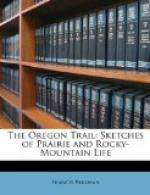of lofty mountains encompassed it; the woods were
fresh and cool in the early morning; the peaks of the
mountains were wreathed with mist, and sluggish vapors
were entangled among the forests upon their sides.
At length the black pinnacle of the tallest mountain
was tipped with gold by the rising sun. About
that time the Hail-Storm, who rode in front gave a
low exclamation. Some large animal leaped up
from among the bushes, and an elk, as I thought, his
horns thrown back over his neck, darted past us across
the open space, and bounded like a mad thing away
among the adjoining pines. Raymond was soon out
of his saddle, but before he could fire, the animal
was full two hundred yards distant. The ball
struck its mark, though much too low for mortal effect.
The elk, however, wheeled in its flight, and ran at
full speed among the trees, nearly at right angles
to his former course. I fired and broke his shoulder;
still he moved on, limping down into the neighboring
woody hollow, whither the young Indian followed and
killed him. When we reached the spot we discovered
him to be no elk, but a black-tailed deer, an animal
nearly twice the size of the common deer, and quite
unknown to the East. We began to cut him up; the
reports of the rifles had reached the ears of the
Indians, and before our task was finished several
of them came to the spot. Leaving the hide of
the deer to the Hail-Storm, we hung as much of the
meat as we wanted behind our saddles, left the rest
to the Indians, and resumed our journey. Meanwhile
the village was on its way, and had gone so far that
to get in advance of it was impossible. Therefore
we directed our course so as to strike its line of
march at the nearest point. In a short time, through
the dark trunks of the pines, we could see the figures
of the Indians as they passed. Once more we were
among them. They were moving with even more than
their usual precipitation, crowded close together in
a narrow pass between rocks and old pine trees.
We were on the eastern descent of the mountain, and
soon came to a rough and difficult defile, leading
down a very steep declivity. The whole swarm poured
down together, filling the rocky passageway like some
turbulent mountain stream. The mountains before
us were on fire, and had been so for weeks. The
view in front was obscured by a vast dim sea of smoke
and vapor, while on either hand the tall cliffs, bearing
aloft their crest of pines, thrust their heads boldly
through it, and the sharp pinnacles and broken ridges
of the mountains beyond them were faintly traceable
as through a veil. The scene in itself was most
grand and imposing, but with the savage multitude,
the armed warriors, the naked children, the gayly appareled
girls, pouring impetuously down the heights, it would
have formed a noble subject for a painter, and only
the pen of a Scott could have done it justice in description.




